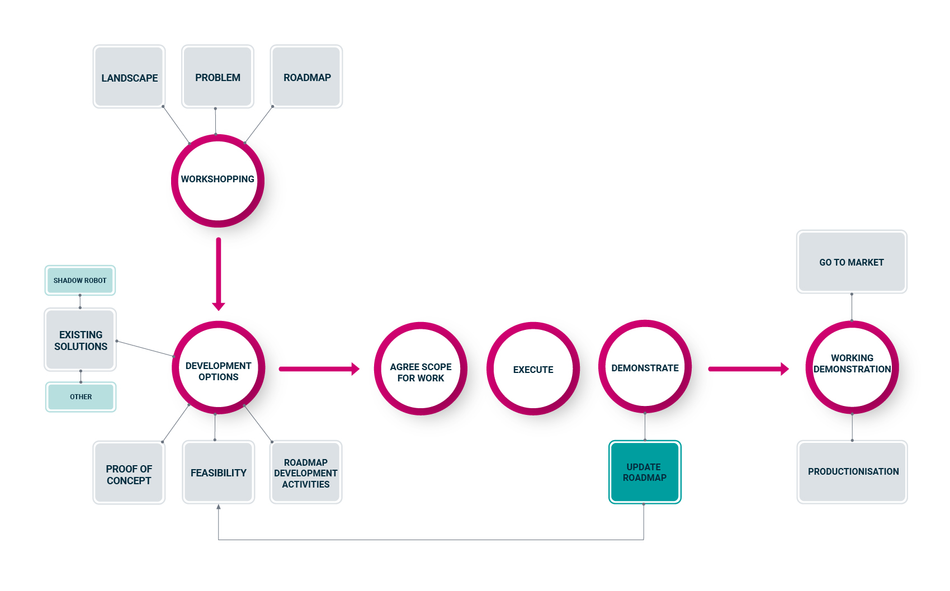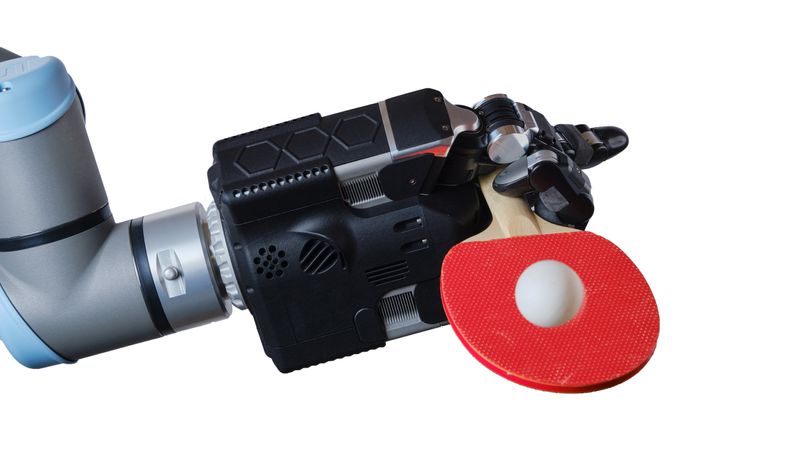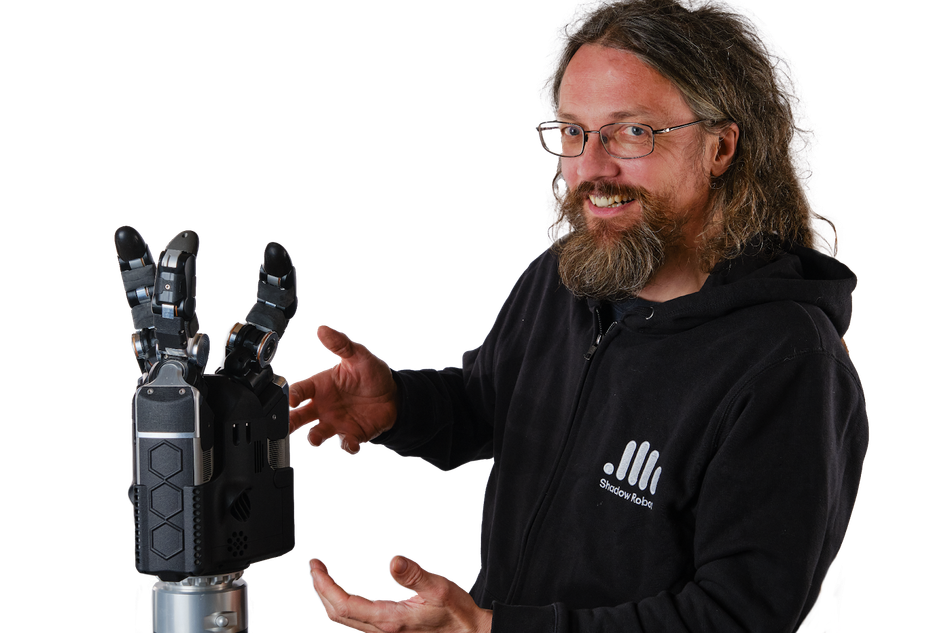Transforming Robotics Through Collaboration: Lessons from Shadow Robot and DeepMind's DEX-EE Project
Shadow Robot’s partnership with Google DeepMind exemplifies how collaboration drives innovation in robotics and AI. This article explores how their expertise in dexterous robotic hands, particularly the DEX-EE, is advancing machine learning research.
In the rapidly changing field of robotics and artificial intelligence, collaboration is the key to pushing the boundaries and opening new possibilities in research. Shadow Robot, a leader in dexterous robotic hand technology is demonstrating this principle through a groundbreaking partnership with Google DeepMind.
Shadow Robot takes a unique approach to collaboration and problem-solving, which has resulted in the development of DEX-EE, a robotic hand that is already transforming machine learning research. This article looks at Shadow’s collaborative methodology and shows how their expertise extends beyond hardware manufacturing, and positions the company as an invaluable research partner in advanced robotic capabilities and artificial intelligence.
Shadow Robot's Collaborative Philosophy
Collaboration is at the heart of Shadow’s engineering philosophy. The team at Shadow prioritizes client needs to make sure that every solution is tailored to meet the specific problems and challenges posed by each client. This dedication to client needs and custom solutions complements the company’s willingness to rethink fundamental aspects of their designs, meaning that the team at Shadow can push the boundaries of what’s possible in robotics.
Shadow’s collaborative approach is based on an iterative development process. By engaging in continuous testing and refinement, engineers at Shadow can adapt designs based on client feedback and evolving requirements. By following this workflow, the company is able to merge academic research and practical applications, building robust robotic hands that can withstand rigorous research.

In their blog post, “Collaborative Working: A Case Study”, Shadow Robot Director Rich Walker captures the company’s philosophy perfectly: “When solving a very general need, such as manipulating objects in the real world, cross-disciplinary collaboration is the only way to move fast enough to build something useful.” The collaborative spirit at Shadow drives innovation and builds strong partnerships, and helps to keep Shadow Robot at the forefront of robotics technology.
The DeepMind Collaboration: A Comprehensive Case Study
The collaboration between Shadow Robot and Google DeepMind began with a huge challenge: DeepMind needed a robot that was capable of enduring long-term, physically demanding experiments as part of their research into generalized intelligence and the role of embodiment in learning. As it was, Shadow Robot’s original Dexterous Hand was not robust enough for the repeated physical impacts required by DeepMind’s learning protocols. To meet this challenge, Shadow and DeepMind needed to work together to find a more reliable solution.
Phased Development Process
The result was a five-year development process to build Shadow’s new DEX-EE hand in collaboration with DeepMind. This project was divided into three phases. At the end of each phase, a usable version of the robot hand was delivered for iterative testing and design changes. Then, the hand was moved on to the next phase to be developed with increasingly complex requirements. The team started with a single finger and refined every element of the design before progressing to the final hand.
Each phase of the development process needed to meet key milestones, including rigorous testing and validation at every stage. By following this iterative development process, Shadow Robot was able to optimize individual components while maintaining a design that was flexible enough to adapt as findings emerged. Gavid Cassidy, head of Product Development at Shadow, noted “Working this way means you can test and refine without being constrained by the overall design.” This approach enabled engineers to isolate any problems with individual components and address them effectively.
Overcoming Challenges
The collaborative project with DeepMind faced significant challenges. One of the biggest hurdles to overcome was to ensure that DEX-EE could withstand the demands of DeepMind’s experiments without compromising data quality. Rich Walker emphasized the importance of adaptability while addressing project challenges: “When we’re working with researchers, we’re always working at the bleeding edge of tech… it’s about being responsive and helping clients develop the things they want to do.”
Throughout the development process, Shadow Robot maintained open lines of communication and worked closely with DeepMind, which meant engineers at Shadow could make adjustments to the scope of the project based on immediate feedback. Shadow’s level of responsiveness strengthened the collaborative relationship and also ensured that each iteration of DEX-EE met DeepMind’s evolving requirements.
Evolution of the Partnership
As development of the new robotic hand progressed, Shadow Robot introduced new avenues for optimization, leading DeepMind to request adjustments in data output levels. To Shadow, this indicated that the project was reaching new levels of innovation, unanticipated by DeepMind. Rich Walker remarked on this achievement: “It’s nice to feel like we were able to exceed their expectations.”
The culmination of this partnership resulted in DEX-EE, a dexterous robot hand designed for functionality, reliability, and versatility, in research applications. Gavin Cassidy reflected on the impact of the project: “This feels like the best example of us working on a customer-led project”.
Future Implications of DEX-EE
Looking ahead, both Shadow robot and DeepMind see vast potential for DEX-EE beyond AI research. The breakthrough technology that resulted from this collaboration is positioned to inspire innovations across industries. According to Rich Walker, “For us, the next step is showing this technology to the world and asking, what can you do now that you couldn’t do before?”
This case study demonstrates how Shadow Robot’s collaborative philosophy brought about astounding technological advancements and established a new framework for future partnerships in robotic innovations.
Shadow’s DEX-EE Innovations
The innovation behind DEX-EE represents a forward step in robotic hand technology. DEX-EE is designed specifically for long-term, physically demanding experiments in machine learning. The hand has a robust construction that allows for extended periods of operation without interruption caused by hardware failure. With these features, DEX-EE demonstrates new possibilities in reinforcement learning research.
One standout feature of the hand is its tactile sensing capabilities. Each finger has hundreds of channels of tactile sensing, including Shadow’s innovative fingertip sensors. These sensors boast hundreds of taxels with an impressive dynamic range. Using this sensory data, research can gather extensive information from dexterous robotic tasks.
Next on the list of innovations is DEX-EE’s precise force control, achieved through high-bandwidth torque and position control loops. This level of control enables delicate and precise fingertip dexterity. The hand can go from fully open to closed in just 500 milliseconds, and can deliver a 10 N fingertip pinch, demonstrating both speed and strength.
DEX-EE is integrated with ROS (Robot Operating System), an open-source framework used in robotics applications in research and industry. This makes the hand a versatile research tool, capable of adapting to the ever-changing needs of machine learning research. DEX-EE’s combination of robustness, advanced sensing, and adaptability is transformative and pushes the boundaries of dexterous manipulation and AI research.
Beyond Hardware: Shadow as a Research Partner (150 words)
The role of Shadow Robot in the field of robotics extends beyond hardware manufacturing. Through collaborative endeavors, Shadow has positioned itself as a research partner in the field of robotics and AI. As demonstrated by the DEX-EE project with Google DeepMind, Shadow is expanding the possibilities of robotics. This collaborative spirit reaches both hardware and software development, and is already leading to innovative solutions that meet the needs of researchers.
Shadow Robot also provides long-term support and engineering services to its clients, which promotes ongoing development and adaptation of their technologies. Shadow’s commitment to partnership gives researchers the ability to focus on advancing their work in AI and robotics, while Shadow provides hardware expertise and support. The company identifies solutions for research by leveraging knowledge and technology gained from collaborative projects like DEX-EE.
Impact on the Field of Robotics and AI
DEX-EE provides researchers with a robust platform for complex machine learning experiments, and opens new possibilities in dexterous manipulation research. The hand has advanced sensor networks and tactile capabilities that can gather vast amounts of data for research, and pushes the boundaries of robotic learning. Google DeepMind has leveraged DEX-EE in their latest system, called DemoStart, where they have achieved remarkable results with practical machine learning tasks, like tightening screws, or inserting a plug into a socket.
The hand’s durability and its integration with ROS position it as a potentially transformative tool for exploring embodied AI and generalized intelligence. As Shadow Robot continues down this innovative path, the implications of DEX-EE extend beyond research and may soon impact real-world robotic applications across industries.
Lessons Learned and Future Collaborations
The DeepMind partnership has helped Shadow Robot shape their approach to collaborative innovation. For Shadow, key takeaways from this collaboration have been the importance of iterative development and the value of cross-disciplinary collaboration in rapidly advancing fields of research. This experience has reinforced Shadow’s commitment to understand and respond to unique client challenges, and has positioned Shadow as an important player in robotics research.

Looking ahead, Shadow is ready to apply these lessons to future projects where they plan to work with clients through adaptability and long-term partnerships. They currently provide consulting services that leverage the technological advances, collaborative processes, and specialist knowledge gained during the development of DEX-EE.
Conclusion
Shadow Robot’s collaboration with DeepMind on the DEX-EE project shows how innovative partnerships can drive technological advancements in powerful ways. Shadow has demonstrated that they are a company at the forefront of dexterous manipulation technology, through their iterative development process, commitment to understanding client needs, and willingness to push boundaries. As the field of robotics and AI evolves, Shadow’s collaborative approach will play an important role in shaping future innovations.
For more insights on Shadow’s collaborative development process, see our article Gripping the Future: Shadow Robot's DEX-EE and the Next Generation of Dexterous Manipulation and check out the Shadow Robot website.
References
1. Shadow Robot. “Shadow Robot unveils the world’s most robust dexterous robot hand, developed in partnership with Google DeepMind”. May 9, 2024. Accessed from https://www.shadowrobot.com/news/press-releases/shadow-robot-unveils-the-worlds-most-robust-dexterous-robot-hand-developed-in-partnership-with-google-deepmind/
2. Shadow Robot. “Unlocking potential: How DEX-EE is Pushing Forward the Frontiers of Innovation”. May 30, 2024. Accessed from https://www.shadowrobot.com/blog/machine-learning-innovation/
3. Google DeepMind. “Our latest advances in robot dexterity”. 12 Sept. 2024. Accessed from https://deepmind.google/discover/blog/advances-in-robot-dexterity/
4. Shadow Robot. “Shadow Robot unveils the world’s most robust dexterous robot hand, developed in partnership with Google Deepmind”. May 9, 2024. Accessed from https://www.shadowrobot.com/news/press-releases/shadow-robot-unveils-the-worlds-most-robust-dexterous-robot-hand-developed-in-partnership-with-google-deepmind/
5. Shadow Robot. “DEX-EE Overview: The most robust dexterous robot hand on the market”. Jun. 6, 2024. Accessed from https://www.shadowrobot.com/blog/shadow-robot-hand-overview/




